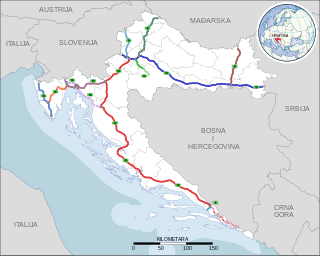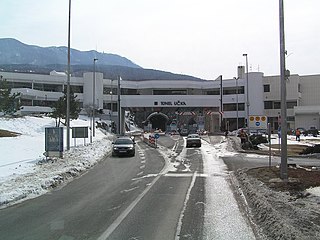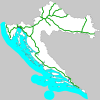
Istria County is the westernmost county of Croatia which includes the majority of the Istrian peninsula.

Kanfanar is a municipality in Istria, Croatia.

The Parenzana in Italian and Croatian or Porečanka in Slovene is one of the nicknames of a defunct 760mm/15 15/16 inch narrow gauge railway between Trieste and Poreč, in present-day Italy, Slovenia and Croatia.

Matulji is a municipality in Primorje-Gorski Kotar County, Croatia. It is located 10 kilometers (6 mi) west of the city of Rijeka, north of the town of Opatija, and it borders Slovenia. Matulji is first mentioned in written historical sources in the middle of the 17th century, and it is preceded by the surname Matulja, which was originally recorded as Matuglia. As early as the beginning of the 19th century, official documents recorded the name of the settlement in its current form – Matulji.

The A2 motorway is a motorway in the Hrvatsko Zagorje region of northern Croatia, connecting Zagreb to the Macelj border crossing and Slovenia. The A2 motorway is part of the European route E59 and the Pan-European Corridor Xa. The motorway spans 59.2 kilometres (36.8 mi) between the Slovenian border and the Jankomir interchange within the Zagreb bypass, providing road connections to a number of cities and towns besides Zagreb, including Krapina, Zabok and Zaprešić. All sections of the motorway, except the northernmost one between the Macelj border crossing and Trakošćan, and the southernmost one near Zagreb, are tolled, using a closed toll collection system.

The A6 motorway is a motorway in Croatia spanning 80.2 kilometres (49.8 mi). It connects the nation's capital, Zagreb, via the A1, to the seaport of Rijeka. The motorway forms a major north–south transportation corridor in Croatia and is a part of European route E65 Nagykanizsa–Zagreb–Rijeka–Zadar–Split–Dubrovnik–Podgorica. The A6 motorway route also follows Pan-European corridor Vb.

The A7 motorway is a 42.4-kilometre-long (26.3 mi) motorway in Croatia. It connects the nation's largest port in Rijeka, to the Croatian motorway network, as well as to the Rupa and Pasjak border crossings to Slovenia. The motorway forms part of a longitudinal transportation corridor in Croatia, and it is a part of European route E61 Villach–Ljubljana–Trieste–Rijeka. The A7 motorway route south of Orehovica interchange, where it also intersects Pan-European corridor Vb, is a part of European route E65.

The A8 motorway is a 64.0-kilometre (39.8 mi) toll motorway in Croatia. It connects the A7 motorway near Rijeka with the road network in the Istrian peninsula via the Učka Tunnel. The road terminates at the Kanfanar interchange with the A9 motorway, which with the A8 motorway forms the Istrian Y road system. The motorway's national significance is reflected in its positive economic impact on the cities and towns it connects, as well as its importance to tourism in Croatia. The importance of the motorway for tourism is particularly high during the summer tourist season, when its traffic volume increases by about 65%.

The A9 motorway is a north–south motorway in Croatia, with a length of 78.3 kilometres. Beginning in Pula, the largest city on the Istrian peninsula, it runs north to the Croatian motorway and expressway network at the Kanfanar interchange. Here it meets the A8 motorway, forming the Istrian Y road system. The A9 continues north from here to the Kaštel and Plovanija border crossings into Slovenia. The motorway represents a significant north–south transportation corridor in Croatia and is a part of the European route E751. The motorway's national significance is reflected in the positive economic impact on the cities and towns it connects, as well as its importance to tourism in Croatia. Importance of the motorway for tourism is particularly high during summer tourist seasons, when traffic volume increases by more than 80%.

The European route E751, or E751, as defined by the Declaration on the Construction of Main International Traffic Arteries of 1975, and subsequent documents which amended the treaty, is an east–west Class-B branching European road route. Originating in Rijeka, Croatia, where it diverges from European route E61 before passing through the Kanfanar interchange, the route connects Pula, Rovinj, Poreč and Umag in Croatia with Koper in Slovenia. The route provides a high-performance road link in Istria and Slovenian Littoral. Unlike most routes, the E751 centers on the Kanfanar interchange and has three arms, each extending to Rijeka, Pula and Koper. The total length of the route, including all the route arms, is 160 km (99 mi).

The Belgrade bypass or Belgrade city road bypass is a U-shaped, 78-km long motorway partially encircling the city of Belgrade, the capital of Serbia.

Highways in Croatia are the main transport network in Croatia. The Croatian classification includes several classes of highways:

The Učka Tunnel is a toll tunnel on the A8 motorway in Croatia, under the Učka mountain range, as part of the Istrian Y network in Istria owned and operated by BINA Istra.

D303 is a state road connecting A9 and A8 motorways to Rovinj. The road is 13.5 km long.

D21 was an 80.1-kilometre-long (49.8 mi), north–south state road in Istria County, Croatia. A short section of D21 was part of the European route E751. The northern terminus of the route was located at the Croatia–Slovenia border at the Dragonja River. There it connected to Koper, Slovenia, and Trieste, Italy, via the Slovene route G11 further north. The route was generally parallel to A9 motorway, with which it formed several junctions, either directly or via short connectors, at Buje, Bale and Vodnjan – towns served directly by D21. The southern terminus of the route was found in the city of Pula, at the southern tip of the Istrian Peninsula.

BINA Istra is a Croatian joint stock company founded in 1995 to facilitate construction and subsequent management of an Istrian Y motorway, consisting of the A8 motorway and the A9 motorway. On September 21, 1995, BINA Istra has been granted concession regarding management of the Istrian Y. The concession agreement is valid until 15 December 2041, when the motorways shall be returned to the Republic of Croatia without any compensation.
Viadukt is a Croatian civil engineering company, specialised in the areas of bridge, tunnel and road engineering. Other business activities of the company include construction and reconstruction of urban streets.

The Mirna Bridge is located between the Nova Vas and Višnjan interchanges of the A9 motorway in Istria, Croatia, spanning the Mirna River and the wide Mirna River valley. It is 1,378 metres (4,521 ft) long and comprises two traffic lanes. The bridge has been open for traffic since June 2005. The bridge is one of the most significant structures on the motorway. The bridge was designed by Zlatko Šavor.

Javorova Kosa Tunnel is one of the most significant structures on the Croatian A6 motorway route. It is 1,490 metres (4,890 ft) long and consists of two tunnel tubes. It is located between Vrbovsko and Ravna Gora interchanges. The tunnel is tolled within the A6 motorway closed toll collection system. There are no other toll plazas related to the use of the tunnel.

The Kanfanar interchange is a cloverleaf interchange west of Kanfanar, Croatia. The interchange represents the western terminus of the A8 motorway and it connects the A8 route to the A9 motorway representing major a link in the Croatian motorway system. The interchange represents a junction of three arms of the European route E751.























